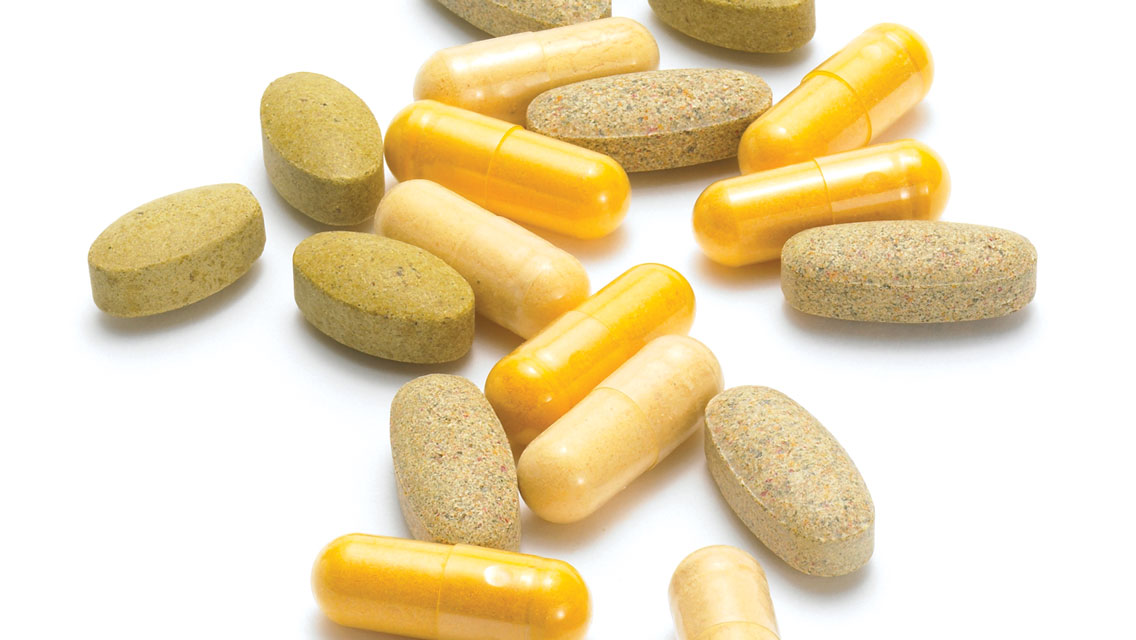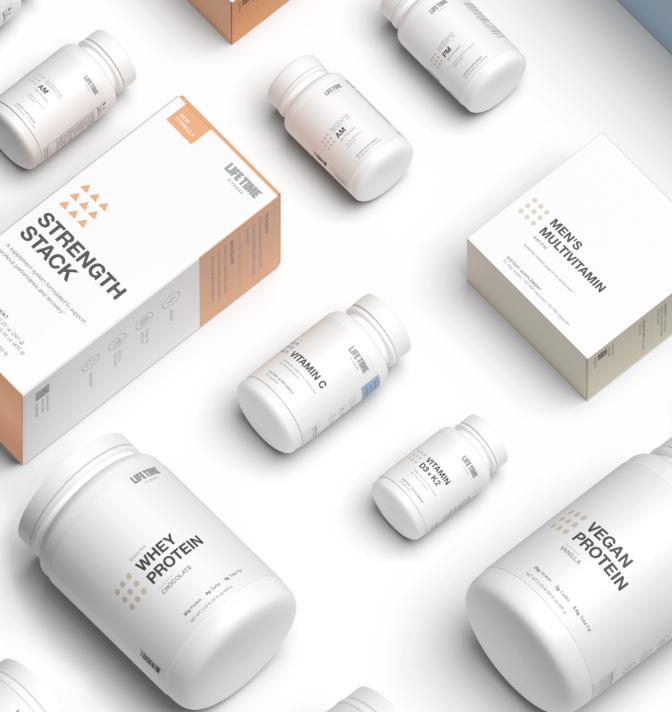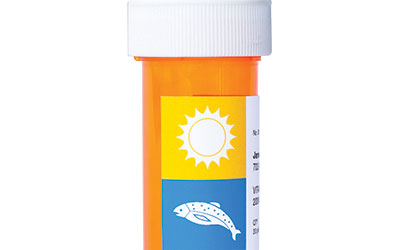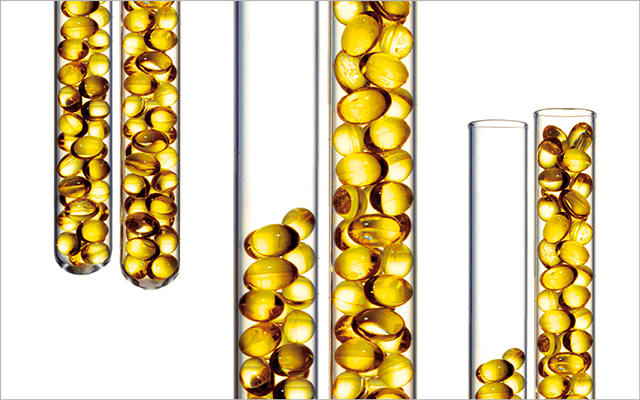In the constellation of vitamins, D has been the rising star. Many doctors now accept the D deficit as a cause of bone loss, fatigue, increased risk of heart disease and even cancer, and they routinely test and treat their patients for this deficiency.
Amid the D mania, though, a quieter movement has emerged: An increasingly vocal group of nutritionists and integrative practitioners argue that B vitamins play a critical role in heart health and immunity, and also provide widely effective treatments for headache, fatigue, mood, stress and menstrual disorders.
“B vitamins are real multitaskers and are involved in so many critical processes,” says Kathie Swift, MS, RD, LDN, nutrition director for Food As Medicine, a professional training program at The Center for Mind–Body Medicine (CMBM) in Washington, D.C. “They are sparkplugs in everything from energy metabolism to detoxification to mood to immunity and gut health.”
Despite all this versatility, there’s plenty of debate in the medical community — especially between conventional and integrative practitioners — about how much vitamin B we actually need to stay healthy. And, even among those who agree that the Bs are vital to our well-being, there are wide variations in how they are integrated into a treatment regimen.
What we do know, however, is how the Bs work in our body, and that can help us make better decisions should we find ourselves needing to ramp up our daily dosage down the road.
The Dispute About Deficiencies
Given how critical B vitamins are to our health and well-being, it’s clear we need to guard against running too low. But, in terms of how common various B deficiencies actually are, the medical community has been embroiled in a bit of a dispute.
Brent Bauer, MD, director of the Department of Internal Medicine’s Complementary and Integrative Medicine Program at the Mayo Clinic in Rochester, Minn., points to three especially high-risk groups who are prone to B deficiency:
- Those over age 65, who are less efficient at absorbing vitamin B-12 through ordinary digestion because of a decrease in the acidity of the stomach.
- Vegetarians, who often miss out on major sources of B-12 in their daily meals.
- Smokers and drinkers, who may find themselves deficient in B-6.
These people often need supplements for better health. Yet, outside of these special groups, many conventional doctors assert, the recommended daily allowance (RDA) is adequate for most of us.
Other practitioners, however, vehemently disagree. They argue that B deficits are far more widespread — and that chronic, low-grade deficiencies pose a serious threat to public health.
Tom Petrie, BS, CDN, nutritionist at the Schachter Center for Complementary Medicine in Suffern, N.Y., for example, says that people under life stress are at risk, as are adolescents feasting on junk food.
“With all our processed food, up to 60 percent of Americans have a B-vitamin deficit.”
James Gordon, MD, clinical professor of psychiatry at Georgetown Medical School and author of Unstuck: Your Guide to the Seven-Stage Journey Out of Depression, agrees: “With all our processed food, up to 60 percent of Americans have a B-vitamin deficit.”
Burt Berkson, PhD, MD, director of the Integrative Medicine Center of New Mexico in Las Cruces and coauthor of User’s Guide to the B-Complex Vitamins, agrees that most of us are woefully deficient. “Most Americans could probably benefit from taking up to three times — or more — of the RDAs for many of the B vitamins,” he writes.
So why the big debate? It may be a matter of perspective: Is the practitioner aiming to cure a disease or boost and achieve an optimal level of health?
“The RDA values were calculated more than 60 years ago during World War II,” writes Berkson, “and their original purpose was not to maximize health and nutrition, but to provide the minimum amounts necessary to avoid flagrant disease.”
For physicians like Gordon, who rely on B vitamins to enhance energy and optimize mood, blood levels deemed adequate by mainstream doctors often turn out to be seriously low.
Keeping a steady supply of B vitamins in the body requires ingesting them daily, because unlike fat-soluble A and D vitamins, water-soluble Bs are not stored by the body. Any Bs not promptly absorbed are washed away.
3 Pivotal Roles Played by Bs
Long ago, B vitamins were considered a single vitamin — just as vitamins C and D are today. But now scientists understand the Bs as a complex of chemically distinct vitamins often found in the same foods and frequently functioning together as a group.
The biochemical actions of the Bs are truly multifarious, affecting every organ system and all aspects of our health. But a few roles stand out: Bs are crucial to methylation, the process by which protein and DNA are produced and sustained in the body; they can lower levels of the amino acid homocysteine, helping us with heart health; and they are pivotal in creating neurotransmitters responsible for brain function and mood.
1) DNA Stabilization
In the process of methylation, a single unit of carbon (otherwise known as a methyl unit) is added to another molecule, propelling the stepwise chemistry of life. Involving hundreds of reactions in all, the interconnected cascade of methylation controls protein and DNA synthesis throughout the body. When methylation is slowed, neurotransmitter levels might fall, resulting in psychiatric issues, and the liver might have trouble clearing toxins from the body and blood.
While B-vitamin deficiency affects the entire cascade, the implications are especially profound when slowed methylation destabilizes DNA, propelling out-of-control cell growth and increasing cancer risk.
Indeed, a raft of recent studies link B-vitamin consumption to a lowered cancer risk. Researchers have associated dietary intake of B-1 and B-3 with improved survival for breast cancer, and folate (B-9), B-2 and B-6 with lowered risk of colorectal cancer. At the National Institutes of Health, a new study shows folate reduces the risk of pancreatic cancer in women. Dozens of such studies across a range of cancers show the Bs are essential in slowing or preventing the disease.
2) Heart Protection
The Bs are also essential for heart health. According to Petrie, preventing and reversing heart disease involves a consistently healthy lifestyle and optimum intake of all the essential nutrients, including a number that are key: vitamin C, vitamin D, vitamin E, omega-3 fats, coenzyme Q10, lipoic acid — and the Bs.
Particularly notable, Petrie and other experts argue, is the role that folic acid, B-6 and B-12 play in lowering levels of the amino acid homocysteine. Though the mainstream medical community has yet to sign on, some studies trace high homocysteine levels to fatty deposits on the endothelium (the thin layer of cells that line the interior of blood vessels), and to blood clots and heart disease itself. It all comes back to methylation: Homocysteine is formed when another amino acid, methionine, loses a methyl group; when homocysteine is methylated, methionine is reformed and homocysteine levels fall.
Even high cholesterol can often be treated with Bs. Studies have consistently shown niacin to be nearly as effective in lowering cholesterol as statins, says Petrie. A recent study reported that niacin reduced levels by an average of 23 percent compared with 32 percent for Lovastatin — a finding that was particularly notable because niacin raised “good” cholesterol levels better than the drug, produced fewer side effects and did not deplete coenzyme Q10.
Petrie says he usually recommends a nutritional strategy: Maintain a diet high in B-6, B-12 and folic acid, and reduce your intake of refined carbohydrates as much as possible. (For more about the importance of folic acid, see “The Difference Between Folic Acid and Folate — and Why It Matters“.)
3) Mood Balancing
Psychiatrists increasingly are turning to the Bs as well. “I use B vitamins regularly, particularly for those feeling depressed and anxious,” psychiatrist James Gordon, MD, says. While Gordon takes a comprehensive approach to patients, providing therapy and adjusting a wide range of nutrients and other factors, he says, “there are times when adding B-12 or folate are game-changers, creating a major shift in symptoms.” And, even in the context of a complete program of supplementation, B vitamins play an important role.
“The B vitamins are vital to the metabolism of all our cells and, in particular, the cells of the nervous system; together with vitamin C, they help maintain an efficient adrenal response to stress,” Gordon explains.
“The B vitamins are vital to the metabolism of all our cells and, in particular, the cells of the nervous system; together with vitamin C, they help maintain an efficient adrenal response to stress.”
Widely accepted observational studies show that up to 30 percent of patients hospitalized for depression are deficient in B-12. In treating depression, Gordon and others think that B supplements are often needed.
An association between low blood levels of folate, vitamins B-6 and B-12 and a higher prevalence of depressive symptoms has been reported in several epidemiological studies.
Other studies suggest that even subclinical levels of B-12 among women and folate among men — levels that might be checked off as normal on an ordinary blood test — may contribute to depression. (See “How B Vitamins Can Help Lift Depression” for more on this topic.)
A recent British study associated lower levels of B vitamins (particularly folate, vitamin B-12 and vitamin B-6) with psychological distress. B-vitamin deficit has also been linked to anxiety and, especially, obsessive compulsive disorder (OCD), and many practitioners have begun to treat OCD with therapeutic doses of the B vitamin inositol. All this makes sense in light of the unbroken link between the neurotransmitters, methylation and the Bs.
Why Bs Matter to the Rest of the Body
Speak to experts in integrative medicine and you’ll find that most include the B vitamins in their therapeutic arsenal for protecting and optimizing general health.
Gordon, for example, uses the B vitamins not just for mood problems, but also for low energy and fatigue.
“Most people are deficient in at least one nutrient, and virtually everyone needs a B-complex vitamin,” he says. Given our processed diets and high levels of stress, depletion is almost guaranteed — “unless you are extremely healthy, eat only whole foods, live in the country, work out daily and experience no stress.”
“Most people are deficient in at least one nutrient, and virtually everyone needs a B-complex vitamin — unless you are extremely healthy, eat only whole foods, live in the country, work out daily and experience no stress.”
For everyone else, he recommends, at minimum, a high-dose multivitamin and a B-50 supplement available at any health-food store. “But some individuals may need more,” he says. Perhaps even high-dose injections of B-12.
With new clients, nutritionist Kathie Swift conducts a nutritional assessment that takes into consideration the person’s lifestyle, typical dietary intake, medical and health history, and clinical signs and symptoms — along with lab data. She often finds a vitamin-B deficiency is at the root of a complaint.
“Take thiamin (B-1), for example” says Swift. “Thiamin insufficiency has a marked effect on the central nervous system, and a thiamin-deficient person may experience fatigue, memory loss, depression, headache and muscle weakness. More severe deficiencies can result in neurological problems and cardiovascular problems, anorexia, weight loss, confusion, and depression.”
At the New York Headache Center, neurologist Alexander Mauskop, MD, uses riboflavin (B-2) along with magnesium, coenzyme Q10 and butterbur to treat migraines. Berkson of the Integrative Medicine Center in Las Cruces mentions treatments involving B vitamins for high blood pressure and inflammation.
At the Morrison Center for Integrative Medicine in New York City, B vitamins are always evaluated in cases of neurological problems, inexplicable pain and fatigue. “The B vitamins are experiencing a creep,” says Jerry Simons, PA, who has worked with the patient group at the center for years. “A few years ago, the labs considered B-12 blood levels of 200 fine, but now serum levels of 200 to 400 are thought of as normal but low.”
Simons says he observes neurological issues like numbness and tingling at the low end of the scale, and he aims to treat his symptomatic patients until they test with a B-12 level of 800 or more.
How to Get the Bs You Need
So, how should the average person integrate the Bs into his or her own life? The first line of defense is food. “I provide my clients whole-food menus that offer them not only the best of the B sources, but also the portfolio of other known and unknown nutrients that are available when one eats the foods we were designed to eat,” Swift says.
According to Michael Murray, ND, author of The Encyclopedia of Healing Foods, foods highest in the Bs include brewer’s and torula yeast, sunflower seeds, wheat germ, liver, and lamb. Other good sources include legumes like kidney and lima beans, clams, peanut butter, and in moderation, beef and tuna fish.
Foods highest in the Bs include brewer’s and torula yeast, sunflower seeds, wheat germ, liver, and lamb. Other good sources include legumes like kidney and lima beans, clams, peanut butter, and in moderation, beef and tuna fish.
For most vegetarians, the elderly and others with blatant deficits, however, experts agree that supplementation is often the answer. (For more information or recommended dosages, see the chart below.)
Yet, when it comes to healthy people outside these categories, there is more room for debate. Even when blood levels are normal at standard labs, Gordon advises off-the-shelf B-complex vitamins. “Everyone can benefit,” he says. Petrie argues that a carefully crafted whole-foods diet can do the trick.
But for those who feel fatigued, depressed or in pain while diagnoses are jettisoned and treatments fail, evaluation of the B-vitamin situation is in order. “Often it helps as part of the bigger picture,” says Gordon, “and every once in a while, it turns out to be the magic bullet.”
List of B Vitamins
The story behind the Bs is nothing if not complex, starting with which nutrients fall into the B category at all.
“The vitamin B-complex consists of 11 nutrients that have similar roles in acting as coenzymes in production of energy and in the metabolism of proteins, fats and carbohydrates,” explains Tom Petrie, BS, CDN, nutritionist at the Schachter Center for Complementary Medicine in Suffern, N.Y. But, those 11 nutrients are divided between the eight classic Bs — B-1, B-2, B-3, B-5, B-6, B-7, B-9 and B-12 — and the three nutrients that are considered honorary B vitamins because they meet some but not all of the requirements of a classic B: para-amino benzoic acid (PABA), inositol and choline.
A note of caution: If you are at high risk for a disease and are using B vitamins in any therapeutic capacity, you should consult a physician who can take note of your risk factors — including family history and genetic profile.
Recommended Dosages for B Vitamins |
B-1 (Thiamin)Recommended Daily Allowance (RDA): 1.4 milligrams (mg) Role in Health: Facilitates smooth functioning of enzymes necessary for function of muscles, nerves and heart. Has been used in treating cancer, heart disease and Alzheimer’s disease. Useful in aiding emotional balance. Best Food Sources: Sunflower seeds, peanuts, soybeans, whole wheat and nuts. Signs of Deficiency: Lack of B-1 has a marked effect on the central nervous system, and a thiamin-deficient person may experience fatigue, memory loss, depression, headache and muscle weakness. Severe deficiency can result in neurological problems and cardiovascular problems, anorexia, weight loss, confusion, and depression. |
B-2 (Riboflavin)RDA: 1.1 milligrams, women; 1.3 milligrams, men Role in Health: Helps maintain health of skin, eyes and nerves. Helps produce niacin (B-3) and pyridoxine (vitamin B-6) from certain amino acids. Used to treat migraines. Best Food Sources: Yeast, organ meats, almonds, mushrooms, whole grains, eggs, soybeans and green leafy vegetables. Signs of Deficiency: Severe deficiency may result in the condition called ariboflavinosis, marked by a sense of weakness, sore throat, mouth problems — including crusty material at the corners or a red tongue — and, in the worst cases, anemia. Those at risk include people with anorexia or those following an extremely low-fat diet. |
B-3 (Niacin)RDA: 14 milligrams, women; 16 milligrams, men Role in Health: Important for health of the digestive system, skin, eyes and hair. In higher doses, niacin may help lower LDL (“bad” cholesterol) and triglycerides while raising HDL (“good” cholesterol) by 15 to 35 percent. Protective for the heart. Essential for manufacture of adrenal hormones and red blood cells. Also important for utilizing fats and carbohydrates. Has been used to facilitate wound healing. Best Food Sources: Liver and other organ meats, eggs, fish, and peanuts. Signs of Deficiency: In the beginning, B-3 deficiency may manifest initially through weakness, sore mouth and tongue, and weight loss. In later stages, deficiency may include diarrhea, inflammation of the skin and mental confusion. Deficiency may follow a serious gastrointestinal illness or alcohol consumption that impedes absorption. |
B-5 (Pantotahenic Acid)RDA: 4–7 milligrams Role in Health: Essential for manufacture of adrenal hormones and red blood cells. Also important for utilizing carbohydrates, proteins and fats. Has been used to lower cholesterol and help treat wounds. Best Food Sources: Liver and other organ meats, milk, legumes, fish, poultry and vegetables. Signs of Deficiency: Deficiency of this B vitamin is reportedly rare, but those with inadequate amounts can experience fatigue, nausea, and the feeling of pins and needles in hands and feet. |
B-6 (Pyridoxine)RDA: 1.5 milligrams, women; 1.7 milligrams, men Role in Health: Helps to form the neurotransmitters serotonin, dopamine and norepinephrin, which are essential for mental health, and the enzyme insulin, which maintains normal levels of blood sugar. Important to the health of red blood cells, the immune system and infection-fighting antibodies. Has been used to treat fatigue and protect the heart. Best Food Sources: Whole grains, legumes, bananas, seeds and nuts, potatoes, Brussels sprouts, and cauliflower. Signs of Deficiency: Deficiency of B-6 can cause a progressive series of problems. Initially, vague symptoms include insomnia, fatigue, depression, gastrointestinal pain and slow wound healing. As time goes on, deficiency can cause anemia and elevated cholesterol. In the latest stages, deficiency can lead to neurological symptoms, seizures and kidney stones. |
B-7 (Biotin)RDA: No RDA, but the Food and Nutrition Board of the Institute of Medicine recommends 35 to 60 micrograms (mcg) a day. Role in Health: Required for synthesis of fatty acids. Also helps to manufacture proteins and in gene expression. Has been used to treat hair loss and brittle fingernails and to stimulate production of insulin in diabetics. Best Food Sources: Brewer’s yeast, organ meats and soybeans. Signs of Deficiency: Anemia, pale or flaking skin, pins-and-needles sensation in the fingers and toes, and sore tongue are some of the symptoms of biotin deficiency. |
B-9 (Folate or Folic Acid)RDA: 400 micrograms Role in Health: Makes red blood cells. According to some studies, up to 800 micrograms of B-9 a day — either from food or a supplement — may help ward off cognitive decline and even reduce the risk of Alzheimer’s disease. For older adults, those who consume alcohol and others who may not get or absorb enough folate, supplements may reduce risk of cancer, especially colon and breast, and may help reduce risk of heart disease. May also help reduce risk of cardiovascular disease. Best Food Sources: Green leafy vegetables such as spinach, kale, beet greens and Swiss chard; and asparagus and avocados. Signs of Deficiency: Those deficient in folic acid may develop anemia and low white-blood-cell counts. Pregnant women are always given B-9 supplements, because deficiency can lead to neural tube deficits, including spina bifida, in the fetus. |
B-12 (Cyano-Cobalamin)RDA: 2.4 micrograms Role in Health: Makes red blood cells. Essential for cell metabolism and function of the nervous system and brain. Older adults should routinely consume extra B-12 from fortified foods or supplements to prevent deficiency. Used to treat fatigue and depression; protects the heart; has been seen as a useful adjunct in cancer treatment. Best Food Sources: Liver, kidney, fish, eggs, poultry, meat and dairy products. Signs of Deficiency: Those with B-12 deficiency may experience fatigue, pale complexion and anemia. Men with B-12 deficit may suffer low sperm counts and problems with infertility. Severe B-12 deficiency has been associated with higher risk of esophageal cancer. |
PABARDA: No RDA Role in Health: Known for antioxidant properties; also blocks ultraviolet light from the sun. Best Food Sources: Organ meats, wheat germ, whole grains, eggs and brewer’s yeast. Signs of Deficiency: Deficiency has never been recorded in humans. |
InositolRDA: No RDA Role in Health: Primary component of cell membranes and important for cell division. Works with choline to help transport fat from the liver. Helps to control blood cholesterol levels. Used in supplement form to treat anxiety, and panic and obsessive compulsive disorder. Best Food Sources: Whole grains, fruits, meats, dairy products and yeast. Egg yolks, organ meats, legumes and lecithin. Signs of Deficiency: Deficiency has never been recorded in humans. |
CholineTechnically not a vitamin, but often considered to be part of the B family. Works with inositol. RDA: No RDA, but the Food and Nutrition Board of the Institute of Medicine recommends 125 to 550 micrograms a day. Role in Health: Needed as primary building block of the neurotransmitter acetylcholine, essential for the cognitive and motor functions of the nervous system. Together with inositol, has been effectively used to treat premenstrual syndrome. Best Food Sources: Egg yolks, organ meats, legumes, peanut butter, lettuce, cauliflower and lecithin. Signs of Deficiency: Since choline is produced by the body itself, severe deficiency is extremely rare; because it is required by every cell, the outcome of such a deficiency would be fatal. |
*Recommended by Integrated Medicine Specialist: Depending upon practitioner and nutritional profile of client.
Too Much of a Good Thing?
We know the B vitamins are critical to our health and well-being, but is it possible to overdo them? Take a look at the list below to find out.
- B-1, Thiamin: No known adverse reactions to higher doses recorded in the literature.
- B-2, Riboflavin: Intake many times higher than the RDA causes no known adverse reactions, but possible reactions to much higher doses include numbness, itching, burning/prickling sensations and dark yellow urine.
- B-3, Niacin: If you buy your B-3 over the counter and treat yourself, you’re unlikely to have side effects with daily intake below 50mg. If you require more, make sure you are under a doctor’s supervision, because side effects, especially facial flushing, may result. If you are on niacin therapy, be sure to monitor liver enzymes.
- B-5, Pantothenic acid: No known adverse reactions to moderate doses. However, larger doses may cause diarrhea and actually inhibit the absorption of B-7, Biotin.
- B-6, Pyridoxine: Large doses of over 100 mg daily, taken over long periods of time, may cause nerve damage.
- B-7, Biotin: Biotin is not known to be toxic. Oral biotin supplementation has been well tolerated in doses up to 200,000 mcg/day in people with hereditary disorders of biotin metabolism. In people without disorders of biotin metabolism, doses of up to 5,000 mcg/day for two years were not associated with adverse effects.
- B-9, Folate or folic acid: High doses of B-9 can mask a B-12 deficiency, allowing associated nerve and cognitive deterioration to proceed unchecked. This can be remedied by taking a supplement that contains 100 percent of the Recommended Daily Allowance of both B-9 and B-12.
- B-12, Cyano-cobalamin: No known adverse reactions to higher doses.
- PABA: Can damage the liver at high doses. Also associated with nausea, vomiting and allergic-type reactions. Can block action of sulfa-containing antibiotics.
- Inositol: High doses may result in diarrhea.
- Choline: High doses (10 to 16 grams/day) have been associated with a fishy body odor, vomiting, salivation and increased sweating.
This article has been updated. It originally appeared in the September 2010 issue of Experience Life.





This Post Has 0 Comments